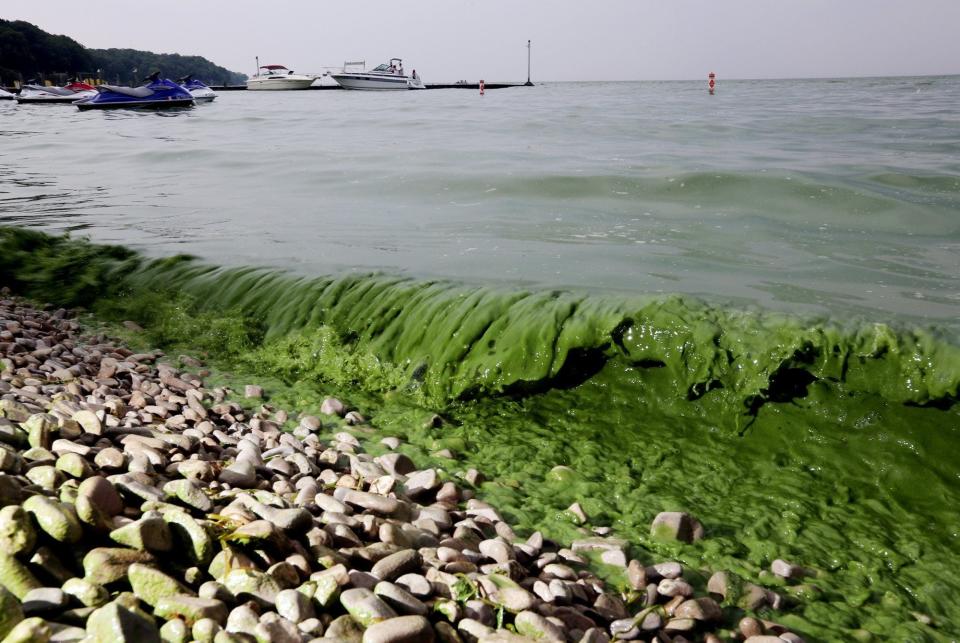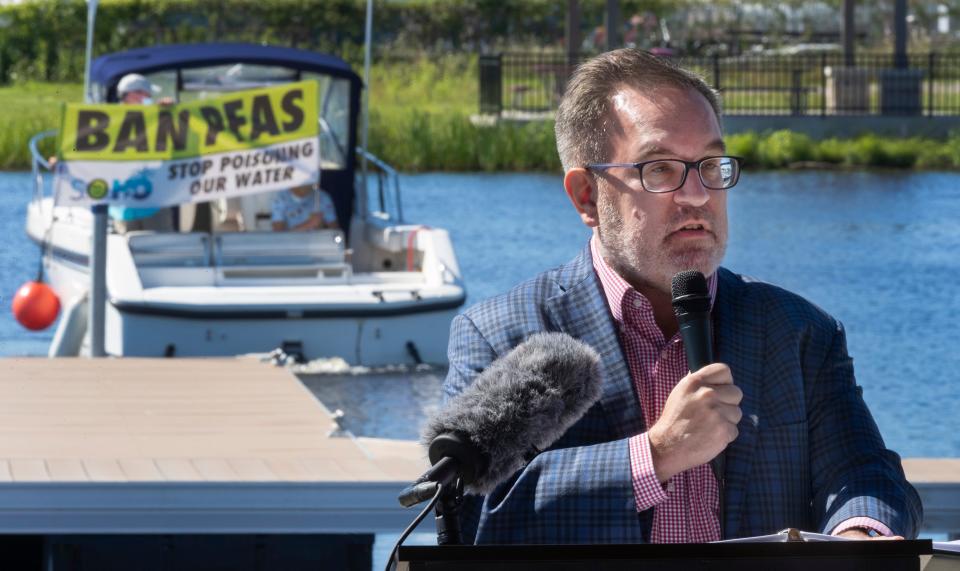What's the state of the Great Lakes? Successful cleanups tempered by new threats from climate change
This year marks 50 years since the U.S. and Canada signed the Great Lakes Water Quality agreement, a commitment to protect and restore the Great Lakes. At the time, Lake Erie was dying from pollution, which helped ignite the modern-day environmental movement.
“The Great Lakes were in a bad state,” said Beth Hinchey from the EPA’s Great Lakes National Program Office. The water quality agreement helped drive a Lake Erie comeback, she said, making it a “phoenix from the ashes.”
But the U.S. EPA and Canada recently released two reports outlining the state of the Great Lakes. Spoiler alert: Lake Erie’s problems aren’t over.
So what is the state of the Great Lakes? Here are six things you should know.
Each lake gets graded
As a part of the water quality agreement, the U.S., EPA and Canada release two reports every three years on the status of the Great Lakes. One report outlines how healthy the lakes are, while the other talks about the groups involved in protecting and restoring water quality and ecosystem health across the lakes.
The State of the Great Lakes report uses nine indicators of ecosystem health: drinking water, beaches, fish consumption, toxic chemicals, habitat and species, invasive species, nutrients and algae, groundwater, and watershed and climate impacts.
Each indicator gets a score in every lake — good, fair or poor — as well as the trend showing if it's improving, deteriorating or unchanging. The report also provides an overall score for each lake.
The Progress Report of the Parties talks about who is doing what work and the key accomplishments for each of the 10 goals in the water quality agreement.
Invasive species, algae blooms stress Lake Michigan
The report also gives a status update on each lake: good, fair and poor, as well as improving, deteriorating and unchanging.
Lake Superior, with its forested watershed and coastal wetlands, ranked “good” and “unchanging” as did Lake Huron, despite nearshore algae blooms in Saginaw Bay.
Lake Michigan, which faces continued stress from invasive species, habitat loss and algae blooms, ranked “fair” and “unchanging.” With fewer beach closings and fish that are becoming safer to eat, Lake Ontario ranked “fair and improving.”

But Lake Erie is “poor and unchanging,” seeing some setback as nutrient runoff remains high, inciting large harmful algae blooms every summer. The National Oceanic and Atmospheric Administration recently bumped up its forecast for this summer’s algae bloom, predicting it will be larger than anticipated due to higher rainfall and nonstop heat.
Related: Toxic algae cocktail brews in Lake Erie
Jen Vanator, the Great Lakes program coordinator at the Great Lakes Indian Fish and Wildlife Commission, would like to see more transparency when it comes to the benchmarks used for each lake’s water quality status. The commission represents 11 Ojibwe tribes in Minnesota, Wisconsin and Michigan who have treaty rights to hunt, fish and gather on Lake Superior as well as land nearby.
Vanator said that Lake Superior, whose trend is listed as unchanging, is now regularly seeing algae blooms when that wasn’t the case before, which “to me, that should signify it's going down.”
Legacy pollution is being cleaned up successfully
One success has been cleaning up legacy pollution in places listed as areas of concern: locations that have suffered severe environmental degradation.

Since the 2019 report, two sites — the Lower Menominee River, flowing through Wisconsin and Michigan and the Ashtabula River in Ohio — have improved so much they are no longer on the list. Across the lakes, the two countries also remediated nearly 1.3 million cubic yards of contaminated sediment — enough to fill more than 45 Mitchell Park Domes.
And the EPA anticipates that the recent billion-dollar boost from the bipartisan infrastructure bill will accelerate the cleanup and restoration of the remaining areas of concern.
Hinchey says that they are also trying to keep tabs on newer contaminants, including “forever chemicals” such as PFAS, making sure they don't plague the environment the way DDT did in the 1970s.
Related: How invasive species changed the Great Lakes forever
According to the report, another success has been keeping new invasive species from infiltrating into the lakes — though the ones that are already here are still plaguing the lakes.
Climate change brings new threats
Across all lakes, the impact from invasive species was the only category where the lakes ranked as “poor.” For example, the invasive quagga mussel, which has drastically changed the food webs, still dominates the lake bottoms.
Climate change is also imposing new challenges, such as lost ice cover, intensifying storms and fluctuating lake levels. But so far, the impact of climate change is on the health of the lakes is “undetermined,” according to the report. Hinchey said they are working hard to monitor and model the ways that climate change may exacerbate some of the issues the lakes are already facing.
A lot of these challenges mentioned in the report are “a legacy of the past,” said Laura Rubin, director of the Healing Our Waters-Great Lakes Coalition advocacy group, who would also like to see a more forward-thinking approach to prevent new challenges, like those imposed from climate change.
Tribes, First Nations, others are important parties in the conversation
When it comes to including tribes, the needle has been moving in a positive direction, but it isn’t moving fast enough, said Vanator.
Through the water quality agreement, the U.S. and Canadian governments work together with tribes, First Nations, Métis, provincial, state and municipal governments and agency partners with the shared goal of having the lakes be fishable, swimmable and drinkable.
The Ojibwe-focused commission is one of the agencies that attends meetings and represents an off-reservation, ceded territory perspective on committees. Unfortunately, many tribes don’t have the capacity to attend every meeting and need more consistent presence to be heard, Vanator said. However, she did add that there were greater efforts to include tribes this year, as they were able to comment on the report before it was released.
One issue is that the reports aren’t written with tribes in mind, she said. This year’s report mentions that it’s safe to eat the fish if people follow consumption guidelines. That may work for someone, like a sport fisherman, who eats fish every now and then, but it doesn’t work for tribes that rely on fish for subsistence, said Vanator.
These aren't just environmental issues
Both Vanator and Rubin agree that agencies need to take a more holistic view on these issues. These aren’t just environmental issues, said Rubin, these issues involve public health and engagement as well as workforce and economic development.
“What it really requires is that we start looking at the intersection of these issues rather than seeing them as just environmental issues,” she said.
Vanator believes that including traditional ecological knowledge with Western science would give Indigenous communities a stronger voice.
The nine indicators that the report uses don’t capture some of the human concerns and impacts, said Rubin, saying that water infrastructure, like wastewater treatment facilities, throughout the region is in a “crisis” state.
“While I say there's been tremendous progress, a lot of that progress… is really focused on the ecosystem health,” said Rubin.
“And we feel as a coalition, that what we've missed… the people in the community.”
Caitlin Looby is a Report for America corps member who writes about the environment and the Great Lakes. Email her at clooby@gannett.com.
Please consider supporting journalism that informs our democracy with a tax-deductible gift to this reporting effort at jsonline.com/RFA.
This article originally appeared on Milwaukee Journal Sentinel: Report on Great Lakes' ecosystem health finds climate change threats

